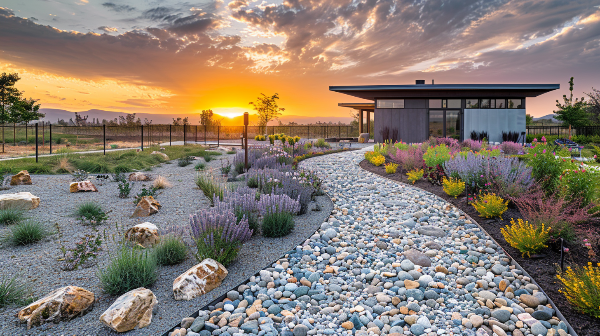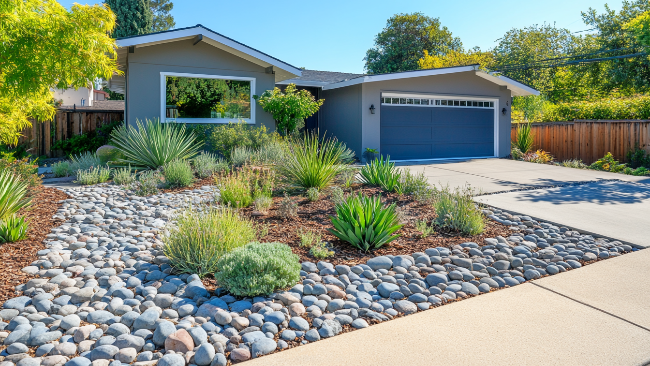Creating a Fire-Resistant Landscape Without Sacrificing Beauty

2025 Landscaping Trends: Drought-Resistant & Beautiful Yards
Wildfires have become an increasing concern for homeowners, particularly in regions prone to dry, hot conditions. While the natural beauty of a lush yard is desirable, it’s essential to consider how your landscaping choices can impact fire safety. Fortunately, you don’t have to sacrifice aesthetics to create a fire-wise outdoor space. By selecting the right plants, designing smart layouts, and incorporating fire-resistant materials, you can enjoy a beautiful and safe yard.
Understanding Firewise Landscaping
Firewise landscaping is a strategic approach to designing and maintaining outdoor spaces to reduce the spread and intensity of wildfires. It involves selecting plants with lower flammability, maintaining proper spacing, and utilizing hardscaping elements to create defensible zones. This method doesn’t just protect homes—it also enhances the overall health and sustainability of the landscape.
Creating Defensible Space Around Your Home
Defensible space is a crucial element in firewise landscaping. It refers to the buffer zone between your home and surrounding vegetation, designed to slow the spread of fire. This space is typically divided into three zones:
Zone 1: Immediate Zone (0-5 feet from your home)
- Use non-flammable ground cover like gravel, stone, or pavers.
- Keep plants low-growing and well-watered.
- Remove flammable debris, such as dry leaves and mulch.
Zone 2: Intermediate Zone (5-30 feet from your home)
- Space trees and shrubs to prevent fire from jumping between them.
- Prune tree branches to at least six feet above the ground.
- Choose fire-resistant plant species with high moisture content.
Zone 3: Extended Zone (30-100 feet from your home)
- Maintain a healthy tree canopy by thinning and pruning.
- Create breaks in vegetation with pathways or driveways.
- Reduce dead wood and ladder fuels that could carry fire upward.
Choosing Fire-Resistant Plants
Not all plants are equally flammable. Some contain more moisture, making them more resistant to fire. When planning your landscape, opt for species with thick, fleshy leaves and low resin or oil levels. For ground cover, options like creeping phlox and ice plant provide both beauty and fire resistance. Shrubs such as lilac and sumac are excellent choices, offering dense foliage with minimal fire risk. Trees like maple and aspen have lower flammability compared to resin-heavy alternatives. Incorporating modern ornamental grasses like blue fescue can enhance aesthetics while remaining fire-conscious, provided they are kept well-watered and trimmed. Keeping plants spaced appropriately helps prevent fire from spreading.
Hardscaping for Added Protection
Hardscaping elements help slow or stop a fire’s progress. Stone or concrete patios reduce fire risk while enhancing outdoor spaces. Gravel walkways create firebreaks that prevent flames from spreading. Retaining walls made of stone or masonry serve as barriers that block fire movement. Choosing metal or stone fencing instead of wood further minimizes fire hazards. These additions improve your property’s aesthetic while offering crucial wildfire protection.
Smart Irrigation and Maintenance
Proper irrigation is key to maintaining fire-resistant landscaping. Well-hydrated plants are far less likely to ignite, making an efficient watering system essential. Drip irrigation helps keep plants healthy while minimizing water waste. Choosing drought-tolerant plants that retain moisture is another effective strategy for reducing fire risk. Regular maintenance, including trimming dead branches and clearing dry debris, prevents the accumulation of flammable material. Seasonal upkeep, such as pruning trees in the fall and spring and inspecting irrigation systems, will help maintain a safer landscape.
Avoiding Common Fire Hazards
Even the most beautiful landscaping can become hazardous if not properly maintained. Overgrown shrubs near structures provide a direct path for fire to reach your home. Dry leaves or wood chips piled too close to the house create a high-risk ignition source. Hanging branches over rooftops or near chimneys make it easier for flames to spread. Rustic design choices, such as wooden trellises and fences, can add charm and character to your outdoor space while still being fire-wise when properly treated and maintained. By selecting fire-resistant finishes and keeping vegetation trimmed around these features, you can enjoy a rustic aesthetic without compromising safety. Addressing these hazards proactively will help lower your property’s wildfire risk.
Protect Your Home While Enhancing Your Landscape
Creating a fire-resistant landscape doesn’t mean sacrificing beauty. With thoughtful plant selection, proper spacing, and the addition of non-flammable hardscaping elements, you can design a stunning outdoor space that also provides critical wildfire protection. By implementing firewise principles, you not only safeguard your home but also contribute to a safer community.
Take the first step today—assess your yard, make necessary changes, and enjoy the peace of mind that comes with a fire-resistant yet beautiful landscape. If you need expert guidance or have questions about making your yard safer, contact us for professional advice and support.
Comments
Other Posts You Might Enjoy
CONTACT
228 Windsor River Road #329
Windsor California
95492
(707) 322-7007
Canepa Landscaping serving the greater Northern California region And Surrounding Areas including: Sonoma County, Marin County, Lake County, Mendocino County and More
© 2021 All Rights Reserved | Canepa Landscaping Inc
Website Design and SEO by Fitz Designz




